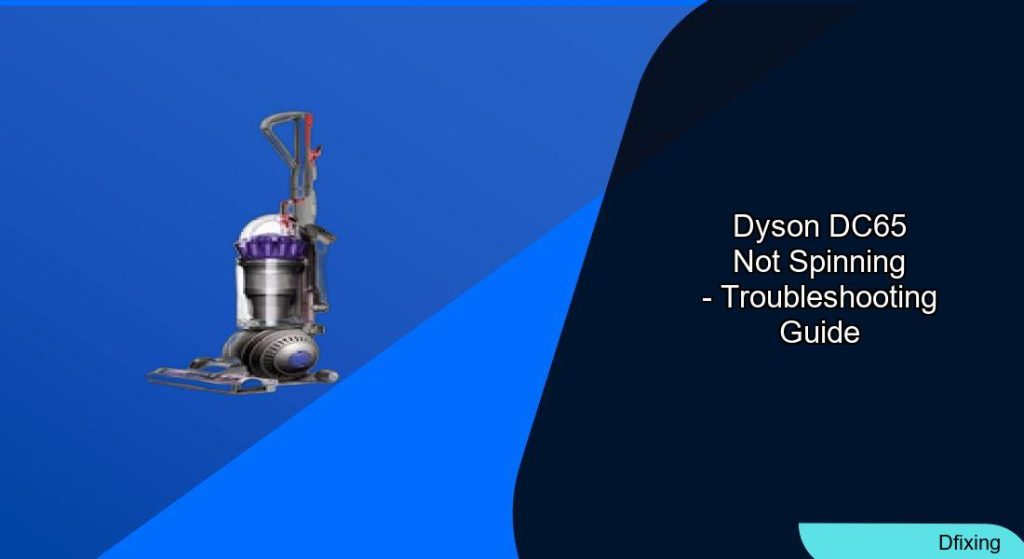A Dyson DC65 vacuum’s brush head is critical for effective cleaning, especially on carpets and rugs. When the brush head stops spinning—or spins unevenly—performance plummets, leaving debris behind and creating frustrating noise. This issue often stems from worn components, debris buildup, or electrical failures. Fortunately, most problems can be resolved with basic tools and troubleshooting. This guide walks you through diagnosing, repairing, and maintaining your Dyson DC65 brush head to restore optimal function.
Affiliate disclosure: As an Amazon associate, We'll earn a commission for every successful order through our affiliate links in the article. However, you won’t be charged anything for this.
Common symptoms include uneven cleaning, reduced suction on one side, and grinding or clicking noises. These issues typically arise from five key causes: worn belts, tangled debris, motor failure, loose wiring, or broken internal gears. Understanding how to identify and address these problems will save time and money, avoiding costly professional repairs.
Common Causes of Brush Head Failure
Worn or Damaged Belt
The belt connects the motor to the brush roller, enabling rotation. Over time, it can fray, snap, or slip out of alignment. A broken belt often results in a stationary brush head despite the motor running.
Debris Entanglement
Hair, threads, or debris can wrap around the brush roller, locking it in place. This is especially common in households with pets or long-haired individuals.
Motor or Electrical Issues
Internal motor failure or loose wiring connections can prevent the brush from spinning. If the motor is silent or unresponsive, it may need repair or replacement.
Broken Internal Gear
The DC65’s brush head contains a plastic gear that can crack or wear out. A broken gear disrupts the mechanical link between the motor and brush roller, halting rotation.
Step-by-Step Diagnosis and Repair
1. Inspect and Replace the Belt
Tools Needed: Needle-nose pliers, flathead screwdriver.
– Location: Inside the brush head assembly.
– Check: If the belt is frayed, broken, or misaligned, replace it.
– Process: Use pliers to remove the old belt, then stretch the new one around the brush roller and motor shaft. Ensure proper tension.
2. Clear Debris from the Brush Roller
Tools Needed: Scissors, cleaning brush.
– Safety: Unplug the vacuum.
– Process: Open the brush head cover using a flathead screwdriver. Cut away tangled hair or debris with scissors and clean thoroughly with a brush.
If the brush roller is consistently getting tangled with hair and debris, a specialized tool designed to remove these obstructions can be helpful in your cleaning arsenal.

Removes tangled hairs from vacuums and brushes quickly
3. Test the Motor and Wiring
Tools Needed: Multimeter (optional).
– Access: Remove the outer casing of the brush head.
– Check: Ensure wires are securely connected to the motor. If connections are loose, reattach them.
– Test: Plug in the vacuum and turn it on. If the motor doesn’t run, it may require replacement.
4. Replace the Internal Gear
Parts Needed: Replacement gear (available on eBay for ~$35).
– Process: Disassemble the brush head, align the new gear with the motor shaft, and reassemble. Ensure the gear’s lip fits securely into the housing.
Advanced Troubleshooting
Deep Cleaning the Roller
If the brush still won’t spin after basic cleaning:
– Disassemble: Remove the roller from the vacuum head.
– Check: Look inside the roller for lodged plastic fragments or compacted debris.
Sometimes the brush roller itself is beyond cleaning and needs to be replaced.

Official Dyson replacement for DC65/DC66/UP13 models, ensuring optimal performance.

Premium third-party replacement with enhanced cleaning efficiency.

Budget-friendly option with precise fit for DC65 models.

Prevents hair entanglement with adjustable brush rotation for pet owners.
Motor/Pulley Assembly Replacement
If the brush spins freely when upside down but stops when upright:
– Issue: Faulty motor or pulley assembly.
– Fix: Replace the motor assembly and secure with T15 and T9 Torx screws.
Battery and Power Checks
Ensure the battery is fully charged and delivering consistent power. Test other motorized attachments; if they work, the problem is isolated to the brush head.
Maintenance Tips to Prevent Future Issues

- Regular Cleaning: After each use, remove hair and debris from the brush roller.
- Belt Inspections: Check the belt monthly for wear and replace if necessary.
- Avoid Overloading: Don’t vacuum large clumps of hair or string at once.
- Filter Care: Clean filters regularly to maintain suction and airflow.
Frequently Asked Questions (FAQ)
Why does my Dyson DC65 brush head stop spinning on one side?
A broken gear or loose wiring often causes uneven rotation. Check for debris first, then test motor connections.
Can I use third-party replacement parts?
Yes. Users report success sourcing gears and belts from eBay for $35, significantly cheaper than official Dyson parts.
How do I prevent hair buildup in the brush roller?
Use a cleaning brush or scissors to remove hair after each session. For persistent buildup, apply a lubricant like WD-40 to the roller shaft.
Conclusion
A malfunctioning Dyson DC65 brush head is a solvable issue with the right tools and knowledge. Start by addressing debris and belt problems, then move to electrical or mechanical repairs if needed. Regular maintenance prolongs the vacuum’s lifespan and ensures consistent performance. By sourcing affordable replacement parts and following this guide, you can tackle repairs confidently—without relying on costly professional services.







